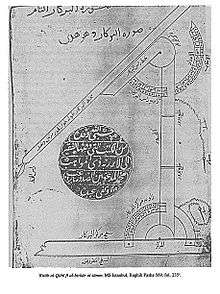Kushyar Gilani
Abul-Hasan Kūshyār ibn Labbān ibn Bashahri Gilani (971–1029), also known as Kūshyār Gīlānī (Persian: کوشیار گیلانی), was an Iranian[1][2] mathematician, geographer, and astronomer from Gilan, south of the Caspian Sea, Iran.
Career
His main work was probably done about the beginning of the eleventh century, and seems to have taken an important part in the elaboration of trigonometry. For example, he continued the investigations of Abul Wáfa, and devoted much space to this in his zij (or collection of tables) az-Zīj al-Jamī wal-Baligh ("the comprehensive and mature tables"), which incorporated the improved values of the planetary apogees observed by al-Battani.[3] The tables were translated into Persian before the end of the century. He wrote also an astrological introduction and an arithmetic treatise Kitab fi usul hisab al-hind (Principles of Hindu Reckoning, extant in Arabic and Hebrew).
He was the teacher of Ahmad Nasawi. He is thought to have died in Baghdad.
See also
References
- ↑ Hockey, Thomas (2014). Biographical encyclopedia of astronomers. New York: Springer. p. 1074. ISBN 9781441999184.
Kushyar ibn Labban was an eminent Iranian astronomer known for his work on astronomical handbooks (zijes) in addition to his work in mathematics and astrology.
- ↑ Selin, Helaine (2008). Encyclopaedia of the history of science, technology, and medicine in non-western cultures. Berlin New York: Springer. p. 241. ISBN 9781402049606.
Another important early treatise that publicized decimal numbers was Iranian mathematician and astronomer Kūshyār ibn Labbān’s (fl. 1000) Kitāb fī usūl hisāb al-hind (Principles of Hindu Reckoning), a leading arithmetic textbook.
- ↑ E. S. Kennedy, A Survey of Islamic Astronomical Tables, (Transactions of the American Philosophical Society, New Series, 46, 2), Philadelphia, 1956, pp. 3, 34-5.
Sources
- H. Suter: Mathematiker und Astronomen der Araber (83, 235, 1900; 168, 1902).
- M Levey and M Petruck (trs.), Kushyar ibn Labban, Principles of Hindu reckoning (Madison, 1965).
External links
- Bagheri, Mohammad (2007). "Ibn Labbān, Kūshyār: Kiyā Abū al‐Ḥasan Kūshyār ibn Labbān Bāshahrī al‐Jīlī (Gīlānī)". In Thomas Hockey; et al. The Biographical Encyclopedia of Astronomers. New York: Springer. pp. 560–1. ISBN 978-0-387-31022-0. (PDF version)
- Laban's Bio from St Andrew's School of Mathematics website, Scotland.
